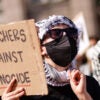Late on Friday, the president of the U.N. Conference negotiating the Arms Trade Treaty (ATT) released his latest draft of the treaty.
A final draft will supposedly come out Wednesday evening, but the changes between now and then should not be substantial, as delegations will then not have time to ask their national capitals about any major new issues before the conference ends on Thursday.
The Daily Signal depends on the support of readers like you. Donate now
The holier-than-thou brigade, led by nations such as Norway and nongovernmental organizations such as Amnesty International, are already complaining that Friday’s draft is too weak. From their point of view, nothing would ever be good enough, but in a way, they’re right. The treaty does not fully include ammunition. It still contains a major loophole allowing nations to ignore the treaty entirely if they have (or claim to have) a defense cooperation agreement with another nation, a key Indian demand. It still allows nations to sell arms unless there is an “overriding” risk of human rights violations. If a nation discovers such a risk after it agrees to make a sale, it is only “encouraged,” not required, to stop the sale. Finally, the new treaty draft “encourages” nations to do many things that are not actually mandatory: Treaty supporters strongly dislike this sort of discretionary language.
The U.S. has won two victories. The scope of the treaty is defined more tightly than before, and the treaty now applies only the standards of the Geneva Conventions of 1949, which the U.S. has ratified. It does not explicitly include the Additional Geneva Protocols, some of which the U.S. has not ratified.
But the most important change in the draft treaty is a major defeat for the U.S. As I foreshadowed in my report on Thursday, the draft now relies on a “knowledge” standard—i.e., before the U.S. sells conventional arms, it is supposed to assess whether it has “knowledge” that they will be used to commit human rights violations. This standard would be used to criticize U.S. sales retrospectively and would be the basis of investigations by the U.N. on the argument that, even if the U.S. did not in fact know about impending violations, it should have known. This standard is completely unacceptable and by itself demands a U.S. rejection of the treaty.
This is not the only weakness in the draft treaty. Its reference to “acts of gender-based violence” in paragraph five of the principles is an open invitation to the U.N. to apply its theory that individual firearms ownership is by definition an undesirable example of masculinity. It still refers to “end users”—individual firearm owners—in Article 11. It effectively makes the definitions of arms contained in the U.N. Register of Conventional Arms nationally binding, which turns part of this voluntary program into a binding treaty commitment and would increase the pressure on the U.S. to include small arms in the formal register.
The draft treaty’s amendment procedure is still unacceptable in that it appears to make amendments adopted by any treaty conference binding on all treaty signatories, even those not at the conference. The preambular passage on the civilian ownership and use of firearms, which was already weak, is now weak and ungrammatical as well. The treaty still opens with separate “Preamble” and “Principles” sections, a novel format to which the U.S. has rightly objected.
That is not a complete list of the draft’s weak points, but it shows that, far from getting better, the treaty is in fact getting worse.
The other major group of nations at the conference—the dictators—have also won on a few points. The treaty now makes much more of the need to eliminate the supply of arms to terrorists. This sounds like a good thing, but in the context of the treaty, the term terrorist actually refers to anyone who rebels against a dictatorship. But the new text also rejects the Arab theory that the purpose of the treaty is to guarantee their right to buy arms no matter how many human rights abuses they commit. It is hard to see how the mere use of “terrorist acts” will satisfy them.
The size and complexity of several key articles in the new draft makes them unwieldy, and there are many cross-referenced articles, which makes the text even more complicated. Key terms such as import and export (never mind the much more complicated term brokering) remain undefined. My sense overall is that the conference president has tried to split the difference by giving Norway’s group the “knowledge standard,” keeping ammunition out of the scope to satisfy the U.S., keeping the contract clause for India, and adding more emphasis on terrorism for Russia and the Arabs.
It is not clear if this approach will work. In my view, the U.S. cannot accept Article 6, and I am not sure that the holier-than-thou brigade will be willing to accept a treaty that continues—predictably—to be riddled with loopholes.































